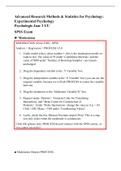Summary
Samenvatting SPSS Guide
- Course
- Institution
In deze samenvatting worden alle statistische toetsen uitgelegd. Daarbij wordt er stapsgewijs besproken hoe je de statistische toetsen in SPSS moet uitvoeren en wordt er vervolgens gekeken naar de interpretatie van de output.
[Show more]



